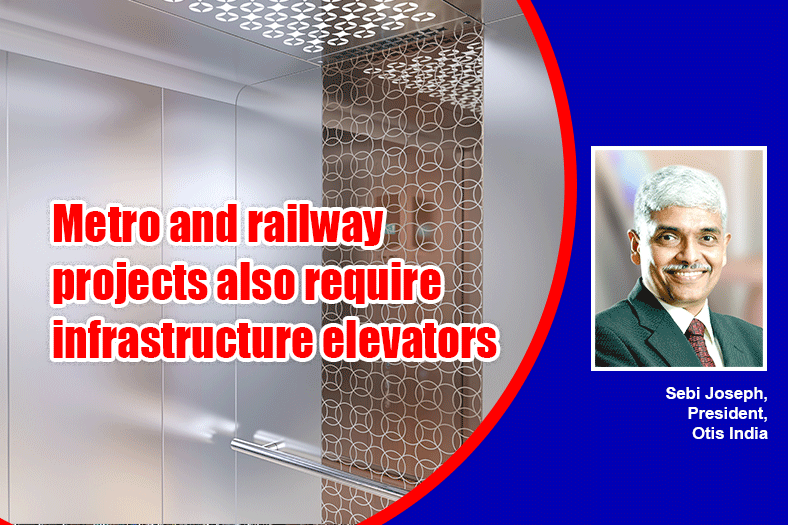Metro and railway projects also require infrastructure elevators

Infrastructure elevators are designed differently, depending on their usage. For example, elevators may have glass walls to offer a panoramic view, including retail and food options, says Sebi Joseph, President, Otis India.
What kind of elevators and escalators are desired for metro and railway projects?
Elevators and escalators installed at metro and railways are designed and adapted for use in public spaces considering the heavy peaks and other traffic patterns throughout the day. This generally warrants the equipment to be especially robust and durable for these special requirements. To help accommodate all passengers, Otis offers elevator buttons with Braille, voice announcing systems and folded seats in the car, among other options.
Metro and railway projects also require infrastructure elevators. Infrastructure elevators are designed differently, depending on their usage. For example, elevators may have glass walls to offer a panoramic view, including retail and food options. Freight elevators, on the other hand, are different from passenger elevators because they carry heavier loads, have wider doors, are taller and avoid glass materials.
Energy efficiency
Most infrastructure projects aim for energy efficiency wherever possible. Otis answers that call with its escalators, moving walkways and elevators. Additionally, many infrastructure projects choose to use Otis’ flagship product, the Gen2 elevator, which underscores the company’s commitment to sustainable technology.
Spacing saving abilities
Gen2 is also desirable because it can save space. The compact elevator components fit inside the hoistway and can eliminate the need for a machine room. This saves construction costs and frees up floor space, which can be especially valuable in metro settings.
Keeping in view that these products are utilised by a large number of commuters, what kind of safety features should they ideally possess?
For Otis, nothing is more important than safety. To that end, our products have a large array of features to ensure passenger safety. Here are some specific features that focus on passenger safety.
• Infra-red door protection systems, a door protection system that consists of invisible infrared beams across the entrance of the elevators. If any beam in the curtain is broken, the door protection system reopens the elevator door instantly without making physical contact with passengers.
• The overload detection feature does not allow the elevator doors to close if the car is carrying passengers beyond the specified limit. The elevator resumes operation only when the extra weight is removed.
• The Automatic Rescue Device (ARD) is especially useful in places where the power supply is irregular. In the event of a power failure, the ARD will bring the elevator car to the nearest floor and will stay on that floor with the door open till the power supply is resumed.
• Seismic sensors installed in buildings are designed to detect earthquakes, with the idea of stopping the elevator at the nearest floor in a case of emergency. This ensures passenger safety as the Seismic sensor can be linked into the elevator controller and can halt the elevator after detecting an earthquake.
Security and access features
With the technology upgrades that have taken place in the industry today, an elevator can also be used to protect tenants or building occupants from intruders, offering security from external threats. Secure Access technologies can require certain codes be entered to allow access to particular floors. Additionally, the elevators can be programmed so that when a passenger inserts a card into the card reader, he or she will be allowed to register a call to certain floors only. This aims to prevent unauthorized access.
Other add-on safety features for elevators include Fire Alarm Home Landing, Intercom, and Emergency Power Operation. With the pandemic in mind, Otis is offering elevator and escalator purification products and services for customers. Some examples of these include:
Elevator purification fans
Elevators can be retrofitted with a fan technology that can inactivate microorganisms. The fan integrates an anion generator and ultraviolet lamp to neutralize germs and filter dust within the cab.
Handrail sanitizers
Fitted on handrails the module is designed to remove germs using ultraviolet light. These solutions also support the recommendations and guidance presented by the World Health Organization (WHO), the US Centers for Disease Control and Prevention (CDC) and other health experts.
What kind of maintenance is required for maximum uptime of these products given the fact that they are utilised very frequently on a daily basis?
These are high traffic zones and people need to keep moving. As such, maintenance is a critical aspect in public spaces like metros and railways to minimize equipment downtime. Maintenance is also important to ensure the performance standard of the elevator and escalator is sustained, as well as to prolong the life of the equipment given its high usage.
Many large infrastructure projects with an Otis Service contract have dedicated field professionals that tend to the equipment throughout the day. At night when traffic is low to nil, these dedicated teams undertake preventive maintenance checks of the units. The main aim of these teams is quick response time coupled with quick resolution to maximize uptime.
To help further this aim, Otis is undergoing a global service transformation that is largely focused on empowering its service teams as well as customers with more information and communication.
Otis is doing that by:
• Empowering field professionals with iPhones that will help increase efficiency, expertise and capabilities.
• Placing sensors on some elevators that can collect data and offer real-time updates on the elevator’s performance.
• Providing customers access to transparent and real-time data on their elevator’s performance.
This same information is tied to apps used by field professionals. Instead of receiving a service call and arriving with little-to-no information, they will be notified about the issue and have a better understanding of potential solutions. Additional equipment performance insights for field professionals help them arrive on site ready with the tools and parts needed to get equipment up and running faster.
Further, we are harnessing the power of data analytics, machine learning and cloud computing to understand elevator health prescribe service. With this, we can analyse trends on our hundreds of thousands of connected elevators to create advanced algorithms that can predict performance trends.
24
Cookie Consent
We use cookies to personalize your experience. By continuing to visit this website you agree to our Terms & Conditions, Privacy Policy and Cookie Policy.









